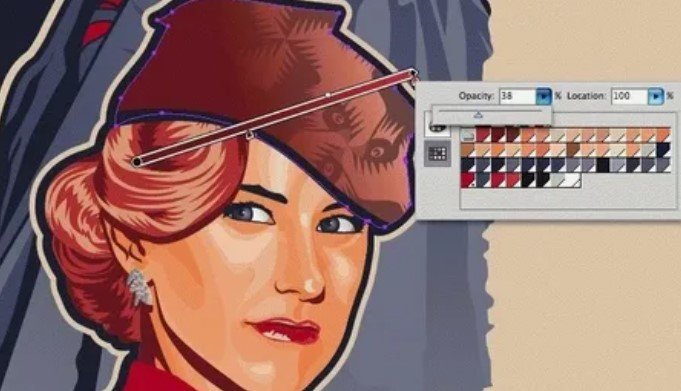Adobe Illustrator is a leading graphic design tool that empowers users to create a variety of digital and printed images, including logos, illustrations, and diagrams. It offers features such as freeform gradients and text-to-vector graphics, providing the freedom to create anything imaginable.
With its industry-leading vector graphics software, Illustrator is widely used for professional design projects. As a graphic design tool, Adobe Illustrator allows users to manipulate and create vector graphics for various purposes. With its advanced features and capabilities, it has become an essential tool for designers, illustrators, and artists.
From creating logos to complex illustrations, Illustrator provides a versatile platform for unleashing creativity. Whether for print or digital media, Adobe Illustrator remains a go-to software for professionals seeking precision and creativity in their design work.
Table of Contents
Adobe Illustrator

Key Features Illustrator
Adobe Illustrator offers a range of key features, including the ability to create vector graphics, manipulate text, and utilize advanced drawing tools. With its powerful tools and intuitive interface, users can easily design logos, illustrations, and complex artwork.
Vector Graphics
Adobe Illustrator offers powerful tools for creating scalable vector graphics that maintain their quality when resized.
Image Tracing
With Adobe Illustrator’s image tracing feature, you can easily convert raster images into editable vector graphics.
Typography Tools
Enhance your designs with Adobe Illustrator’s diverse typography tools for creating custom text effects and layouts.
Tools And Workspace
Adobe Illustrator is a powerful tool for creating stunning vector graphics. Understanding its tools and workspace is crucial for efficient design. Let’s explore the key aspects of the workspace and the essential tools it offers.
Selection Tools
Adobe Illustrator provides a range of selection tools that allow precise manipulation of objects. These include the Selection Tool, Direct Selection Tool, and Magic Wand Tool. The Selection Tool helps in selecting entire objects, while the Direct Selection Tool is ideal for manipulating individual anchor points. The Magic Wand Tool simplifies the selection of similar colored or textured areas.
Drawing Tools
When it comes to drawing tools, Adobe Illustrator offers a diverse set to unleash your creativity. The Pen Tool allows for precise and customizable lines and shapes. The Pencil Tool enables freehand drawing, while the Brush Tool offers a wide range of brush styles for artistic strokes. Moreover, the Shape Tools provide quick access to standard shapes such as rectangles, ellipses, and polygons.
Color Tools
In the realm of color tools, Adobe Illustrator excels with its versatile options. The Color Palette and Swatches Panel allow easy selection and application of colors. Additionally, the Gradient Tool enables the creation of smooth color transitions, enhancing the visual appeal of designs. Furthermore, the Eyedropper Tool facilitates the sampling of colors from existing objects, ensuring consistency in the color scheme.
Creating Artwork
Create stunning digital and printed artwork with Adobe Illustrator, the industry-leading vector graphics software. With powerful tools like the Dimension Tool and Generative Recolor, Illustrator empowers you to create anything you can imagine with ease.
Creating Artwork in Adobe Illustrator online is a breeze with its many features and tools. Whether you are a beginner or a seasoned professional, Illustrator has everything you need to create stunning designs. In this article, we’ll take a closer look at some of the ways you can create artwork using Adobe Illustrator.
Using Shapes And Paths
One of the most basic ways to create artwork in Adobe Illustrator is by using shapes and paths. The shape tools allow you to create basic shapes such as rectangles, circles, and polygons. The path tools, on the other hand, allow you to create more complex shapes by drawing freehand or using the pen tool. Once you have created your shapes and paths, you can fill them with color or apply strokes to outline them. This is a great way to create simple yet impactful designs.

Working With Layers
Another essential feature of Adobe Illustrator is the ability to work with layers. Layers allow you to organize your artwork into different levels, making it easier to edit and modify individual elements. For example, you can create a separate layer for your background, another for your text, and another for your graphics. This way, you can easily move, resize, or delete individual elements without affecting the rest of your artwork.
Utilizing Effects
Adobe Illustrator offers a wide range of effects that you can apply to your artwork, such as drop shadows, gradients, and distortions. These effects can help you add depth, texture, and dimension to your designs. For example, you can use the freeform gradient tool to create a gradient that follows the shape of your object, giving it a more natural look and feel. You can also use the generative recolor tool to automatically change the color scheme of your artwork. In conclusion, Adobe Illustrator is an incredibly versatile tool that allows you to create artwork in a variety of styles and formats.
Exporting And Printing
When using Adobe Illustrator, the process of exporting and printing your designs is a crucial step to ensure your work is ready for various uses, from digital platforms to physical prints. In this section, we will explore the different file formats for export and the essential print settings in Adobe Illustrator.
File Formats For Export
When preparing your artwork for export in Adobe Illustrator, it’s essential to choose the right file format to maintain quality and compatibility. Here are some common file formats to consider:
- SVG (Scalable Vector Graphics): Ideal for web graphics and scalable without losing quality.
- PDF (Portable Document Format): Suitable for print and digital distribution, preserving vector elements and text.
- JPEG (Joint Photographic Experts Group): Great for web images and photographs, but not ideal for retaining vector properties.
- PNG (Portable Network Graphics): Preferred for web graphics with transparency support.
- EPS (Encapsulated PostScript): Commonly used for print and vector-based graphics.
Print Settings
When preparing your designs for printing from Adobe Illustrator, consider the following print settings to ensure the best output:
- Color Mode: Ensure your document is set to CMYK for print, or RGB for digital use, to maintain accurate color representation.
- Resolution: For print, set the resolution to 300 DPI (dots per inch) to achieve high-quality output.
- Bleed and Crop Marks: Enable bleed settings to avoid white edges on printed materials, and include crop marks for accurate trimming.
- Print Preview: Always review the print preview to check for any layout or color discrepancies before sending your design to print.
Advanced Techniques
Unlock the full potential of Adobe Illustrator by mastering advanced techniques that will elevate your design skills to the next level. From precise vector creations to intricate patterns and dynamic brushwork, delve into these advanced features to bring your designs to life.
Pen Tool Mastery
Mastering the Pen Tool in Adobe Illustrator is essential for creating precise and intricate vector graphics. With the Pen Tool, you can create complex shapes and paths with precision and control, allowing you to achieve detailed and polished designs.
Creating Patterns
Unlock the power of pattern creation in Adobe Illustrator to add depth and texture to your designs. By utilizing the Pattern Tool, you can effortlessly generate seamless patterns that can be applied to various elements in your artwork.

Working With Brushes
Elevate your designs with custom brushes in Adobe Illustrator. By experimenting with different brush styles and settings, you can add dynamic strokes and textures to your artwork, giving it a unique and artistic flair.
Tips And Tricks
Learn essential tips and tricks for mastering Adobe Illustrator, from creating custom vector graphics to mastering the pen tool. Discover insider techniques for efficient workflow and advanced design features to elevate your creative projects. Unlock the full potential of Adobe Illustrator with expert insights and strategies.
Keyboard Shortcuts
Mastering Adobe Illustrator keyboard shortcuts can significantly enhance your workflow. For example, Ctrl+C for copying and Ctrl+V for pasting objects quickly.
Customizing Preferences
Customizing preferences in Adobe Illustrator allows you to tailor the software to your needs. Adjust settings for tools, workspace layout, and more.
Using Templates
Utilizing templates in Adobe Illustrator can save time and provide a foundation for your projects. Choose from a variety of pre-designed templates to kickstart your work.
Conclusion
Adobe Illustrator is a powerful tool for creating diverse digital and printed images. Its features like freeform gradients and dimension tools, offer endless creative possibilities. Whether you’re a beginner or a professional, Illustrator provides the freedom to bring your imagination to life effortlessly.

